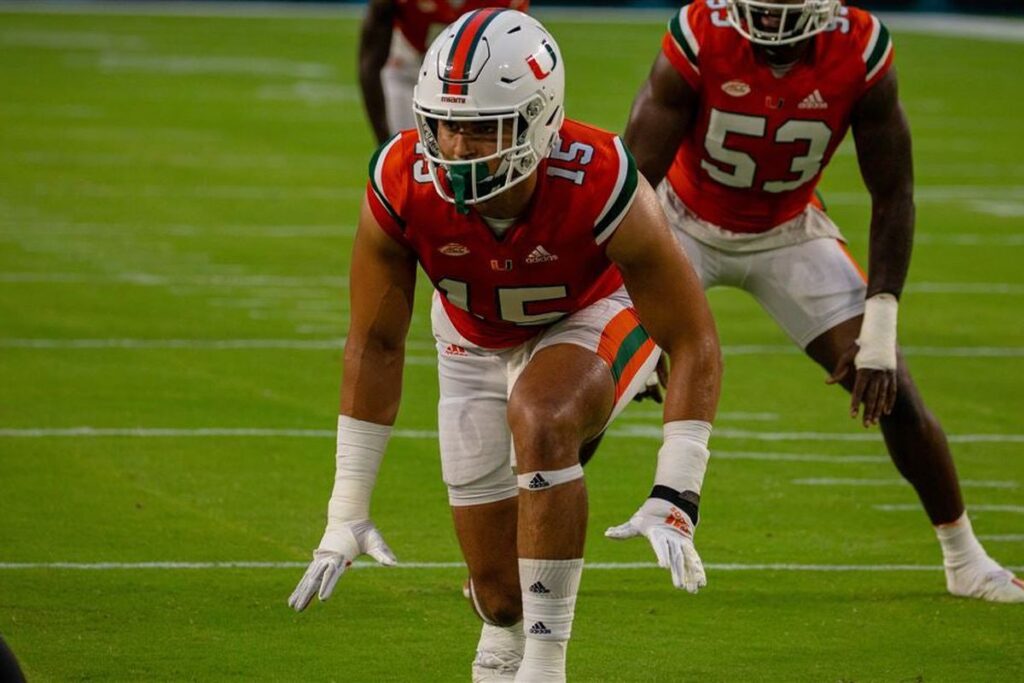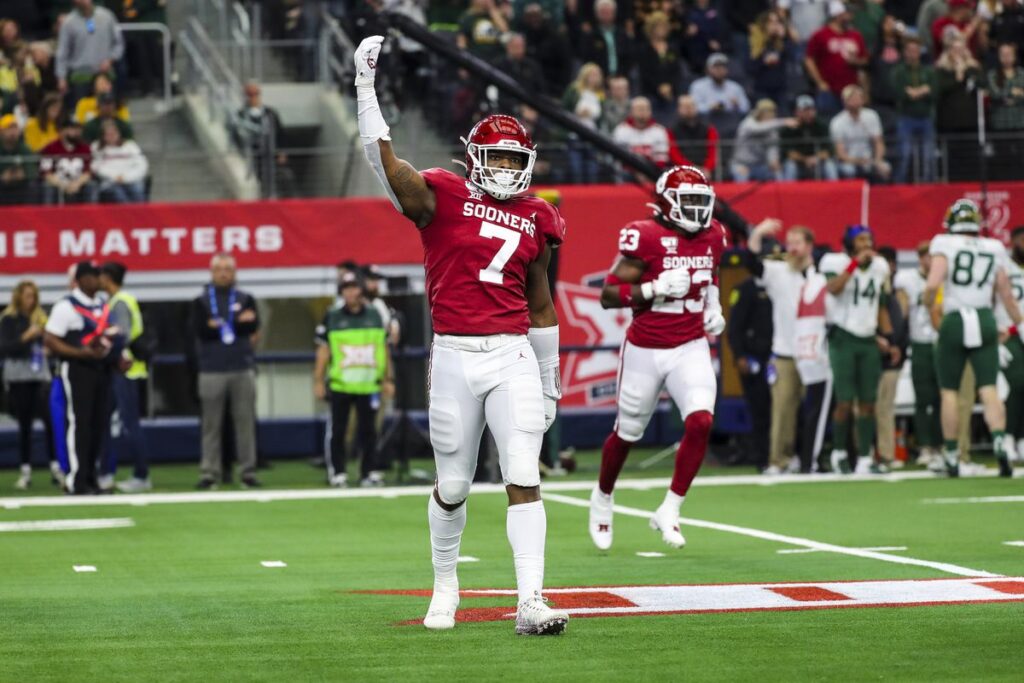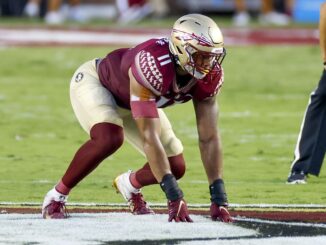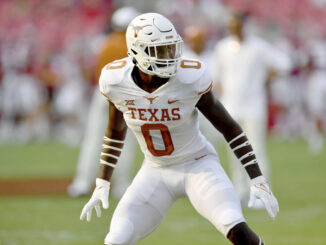The 2021 Edge class may be the most divisive position group in this year’s draft. There is no standout prospect like there has been for the past few years. Instead there are a number of big names with incredible athletic ability but limited collegiate production. That is not to say it is lacking talent though. I have four edges with first round grades and the position accounts for 13 of the top 100 on my Big Board. Here are my top ten edge prospects in the 2021 NFL Draft.
1. Kwity Paye – Michigan

Pros: If you wanted to build an edge rusher with the ideal combination of strength and athleticism, they would look like Kwity Paye. He showcases great power at the point of attack with a really effective bull rush. For a big edge he possesses surprising twitch and has reportedly run a 6.37 three-cone. This would be the third fastest time by any player regardless of position since 1999. Paye managed to translate his rare traits into a string of dominant performances in 2020 and he looked like one of the best edges in the country. His 25.8 per cent pass rush win rate led all players on this list and he racked up 22 pressures on just 138 pass rushing snaps.
Cons: Whilst Paye showed some real improvement in 2020, he remains a little raw from a technical perspective. His pass rushing moves are still developing and at this point he hasn’t really shown the ability to counter consistently. He has normally been able to win with sheer power and remains a little over-reliant on that approach. Paye offers good size, but his length isn’t ideal. His 33″ arms rank in the 42nd percentile at the position. Despite being a senior, his instincts are still developing too, and this shows most notably against the run.
Projection: 1st round
2. Jaelan Phillips – Miami

Pros: Phillips is the most polished pass rusher in this class. He has shown the ability to use a wide variety of moves and to win in a number of different ways. He’s capable of combining moves too and his hand usage is easily amongst the best in the class. He is coming off a breakout 2020 season that saw him rack up 42 pressures and nine sacks on just 284 pass rushing snaps. Phillips is an elite athlete, with great quickness and burst off the line. He combines this with the necessary power to be a force in the running game too and does a good job of setting the edge. He reads the game really well and plays with a consistently high motor.
Cons: Phillips’ medical history is a major red flag and is the only thing keeping him from being a potential top ten pick in this year’s class. Phillips suffered three concussions during his time at UCLA and was forced to medically retire from football. He also had issues with a high ankle sprain and a serious wrist injury as a result of a traffic collision. He stayed healthy for the 2020 season but that was a notable outlier in his career so far. Phillips has played just 962 snaps over the last four years and more than half of them came in 2020. This season was also his only period of substantial collegiate production.
Projection: 1st round
3. Jayson Oweh – Penn State

Pros: This edge class seems to have plenty of great athletes, but Oweh is a cut above the rest. He is incredibly explosive and recently ran a 4.39 40 at his pro day, the fastest ever at the position. He also set the positional record with an 11’2″ broad jump and had an elite 39.5″ vertical. Oweh combines this burst with ideal length, boasting 34.5″ arms. Despite not registering a single sack in 2020 he was still a productive pass rusher, with 20 pressures on just 171 pass rushing snaps. Oweh also developed into an excellent run blocker and plays with consistently great leverage. He is still barely scratching the surface of his potential, having only started playing football as a a junior in high school.
Cons: Oweh is a really raw prospect and inexperienced at the college level. 2020 was his first full season as a starter and he still has just 744 career snaps to his name. His pass rushing moves are notably underdeveloped and he typically wins on the back of his superior athletic tools rather than technique. If his first move fails he doesn’t really offer much in terms of alternatives. Oweh’s 16.6 per cent pass rush win rate was the second lowest on this list in 2020, ahead of only Carlos Basham. His instincts and ability to read the game is clearly still developing too.
Projection: 1st round
4. Azeez Ojulari – Georgia

Pros: Ojulari is the best pure speed rusher in this class. He showcases great initial burst and has the ability to consistently test the outside shoulder of tackles. He plays with great bend and does a nice low of staying low throughout the rep. His length is a major plus and allows him to keep opponents from getting inside his frame. His cross-chop move is particularly effective and was a major part of his success in 2020. Ojulari was the most productive pass rusher on a per-snap basis in this year’s class, finishing with 37 pressures on just 193 pass rushing snaps. He also offers the versatility to drop off and play in coverage.
Cons: At 6’2″ and 249 lbs he is on the smaller end of what you want in an NFL edge rusher. Whilst his speed and quickness helped him have great success in college, he remains a little one-dimensional with his pass rush plan. Ojulari is always looking to attack the outside shoulder of opponents and will need to do a better job of diversifying his attack at the next level. He displays good effort against the run but lacks the functional strength to stand in against bigger blockers. He benefitted from Georgia’s rotational edge lineup and was kept fresh, averaging just 37.5 snaps per game in 2020.
Projection: 1st round
5. Ronnie Perkins – Oklahoma

Pros: Perkins is a really explosive pass rusher with some of the best initial burst in this year’s class. His speed is legitimately impressive and there were occasions where he chased down wide receivers and running backs in the open field. He wasn’t asked to at Oklahoma, but Perkins has the athleticism to drop off into coverage if required. He is a bendy pass rusher who does a nice job of staying low and maintaining leverage. Despite lacking ideal edge size, Perkins plays with good strength and has noticeably powerful hands. Perkins also proved himself to be a genuinely impressive run stopper. His 90.7 PFF run defense grade ranked as the second best amongst FBS edge rushers in 2020.
Cons: Perkins is something of a one season wonder in college. His six games in 2020 were a huge improvement on anything that came before and we haven’t seen a sustained period of success. There will be some off-field concerns too, as Perkins was suspended at the end of the 2019 season as a result of a failed drug test. In terms of his on-field ability, he needs to a better job of combining his pass rushing moves. At the moment he struggles if his initial attack fails. His best work came from a three point stance, but at 6’2″ and 253 he is on the smaller end of what you would want in a 4-3 defensive end.
Projection: 2nd round
6. Carlos Basham Jr. – Wake Forest

Pros: At 6’4″ and 285 lbs, Basham is one of the biggest edge rushers in the 2021 class and plays with serious power at the point of attack. He combines this with impressive athleticism and showcases great burst off the line. Production is one of Basham’s biggest selling points and few can match his record over the past three years. Since 2018, Basham has racked up 137 total pressures and 23 sacks. His hand technique is really impressive and he has a number of pass rushing moves to choose from. His swim move is particularly effective and he also employs the bull rush and long arm to great effect. He plays with a really high motor and gives his all on every play.
Cons: Basham has a frustrating habit of playing upright and needs to do a better job of maintaining low pad level. He also lacks great bend, although that isn’t a major surprise given his size. His hips can be a little stiff and this impedes his change of direction ability. He took a notable step back as a pass rusher in 2020 and looked to be carrying some bad weight. This dip in form was potentially the result of him contracting COVID-19 over the summer, but it will still concern teams. As a run defender he is sufficient, but nowhere near as impressive as you would expect from a player of his size.
Projection: 2nd round
7. Gregory Rousseau – Miami

Pros: Rousseau offers the ideal combination of size and length to cause problems for opposing linemen. He plays with great bend considering his size and has excellent initial quickness off the snap. He only transitioned to the position as a senior in high school but showed in 2019 that he could be productive. His 16 sacks in 2019 ranked second to only Chase Young and that came in his first season as a starter. Rousseau also offers the versatility to win from the edge or the interior and has had success at both spots. He is still developing, but he has the tools that you look for in a prospect.
Cons: Rousseau is incredibly raw as a pass rusher and his sack numbers don’t tell the full story. A large amount of his production actually came from the interior, but at his current size he will struggle to win there in the NFL. His 17.2 per cent win rate ranked 44th amongst edges with at least 200 pass rushing snaps in 2019. He lacks any technique to his pass rushing plan and typically won with his physical tools. That won’t work in the NFL. Rousseau’s pro day numbers were seriously disappointing and he lacks the high end athletic tools that you look for in a developmental player.
Projection: 2nd round
8. Joseph Ossai – Texas

Pros: Ossai is an excellent athlete with some of the best movement skills you will find at the position. Prior to 2020 he played a hybrid linebacker role that often required him to drop back into coverage. He has the quickness and burst you want from an edge rusher and would be an ideal fit in a 3-4 defense that utilises him as a wide-9 rusher. He is still pretty new to a conventional edge role but took to it very well in 2020, with 33 pressures on 312 pass rushing snaps. Ossai plays with a noticeably high motor and gives his all on every play. Despite his lack of size he is also a solid run defender.
Cons: Ossai doesn’t have ideal size to play edge in the NFL. He also lacks ideal play strength and has problems when facing off against more powerful linemen. He struggled particularly against Teven Jenkins when he played Oklahoma State and this is the kind of thing that could be more of an issue at the next level. Ossai also lacks the fluidity and dynamic athleticism that you typically expect from an undersized edge. He’s not as bendy as other speed rushers like Ojulari and Perkins and is a little one dimensional in his attack plan. Despite his background as a hybrid player he is something of a liability in coverage.
Projection: 2nd round
9. Payton Turner – Houston

Pros: Turner is one of the longest edges in the class, standing at 6’6″ and 270 lbs, with 35″ arms. Given his size, Turner is comfortably playing as a traditional defensive end in a 4-3 and as a 5-tech in a 3-4 front. He combines his size with genuine athleticism and is an impressive mover for a man of his size. There was even a play against BYU where he chased down a wide receiver screen. Turner has already shown that he has a variety of pass rushing moves he can win with, including the club-swim, push-pull, and the bull rush. He’s a solid run defender who does a nice job of setting the edge and stacks and sheds consistently.
Cons: There isn’t a tonne of top level production on Turner’s tape. He looked incredible in 2020 but played just four games. His pass rushing production was impressive, but that came on just 201 pass rushing snaps. His 2019 tape wasn’t nearly as good and he didn’t have much in terms of production before that. He also didn’t face much in terms of NFL talent on opposing offensive lines. When he did do, against BYU, he was noticeably less disruptive. Unsurprisingly given his size, Turner can struggle to stay low as a pass rusher and doesn’t have great bend off the edge.
Projection: 3rd round
10. Rashad Weaver – Pittsburgh

Pros: Weaver is a prototypical power end, with the length and power to cause a tonne of problems for opposing tackles. His hand technique is consistently impressive and he knows how to vary up his pass rushing moves. His cross chop and swim move are both particularly impressive. He is a polished technician who has been productive throughout his college career. He recovered from a torn ACL in 2019 to put together his best tape in 2020, racking up 48 pressures and 10 sacks on just 306 pass rushing snaps. Weaver is a solid run defender who does a good job of setting the edge and maintaining gap integrity.
Cons: Weaver lacks the burst and speed that you typically want in an edge rusher. He lacks any sort of twitch to his game and his change of direction ability is not particularly impressive. Whilst he appeared to make a full recovery, his torn ACL in 2019 will be a concern. Weaver is also one of the older edge rushers in this year’s draft, turning 24 in his rookie year. Like a lot of bigger edge rushers, Weaver can struggle to play with consistent leverage and his pad level tends to be rather high.
Projection: 3rd round


